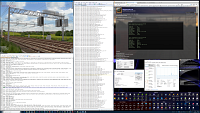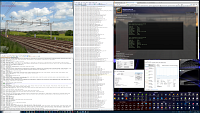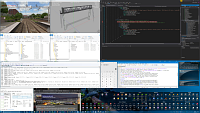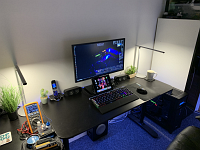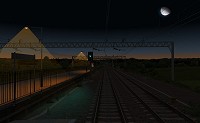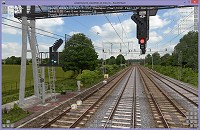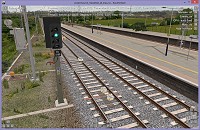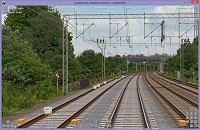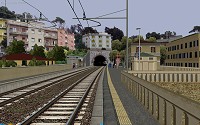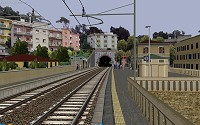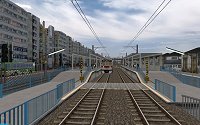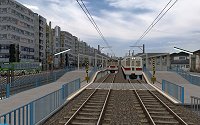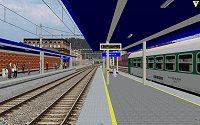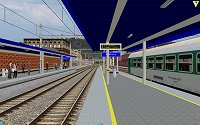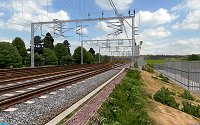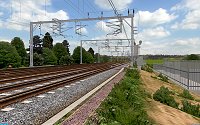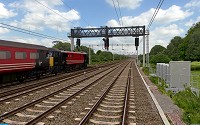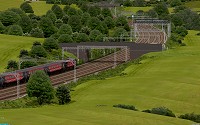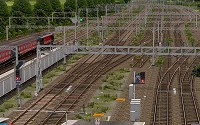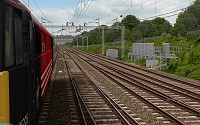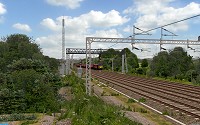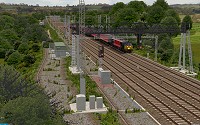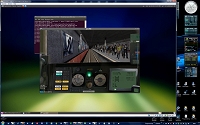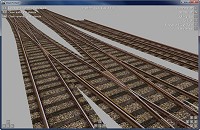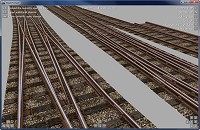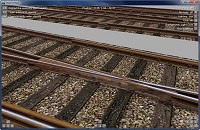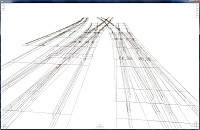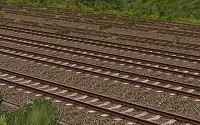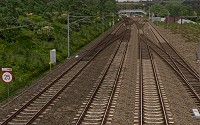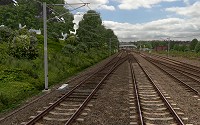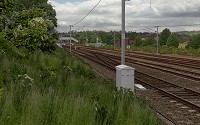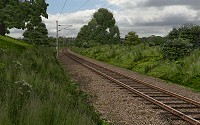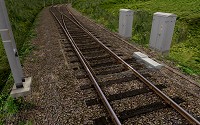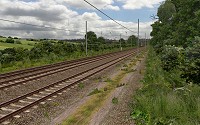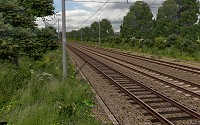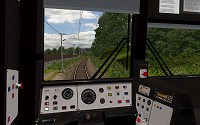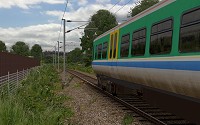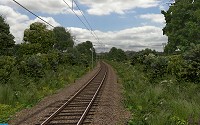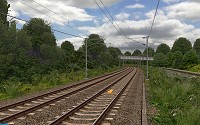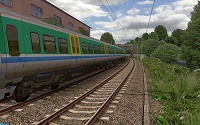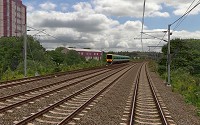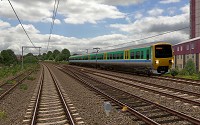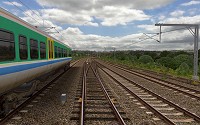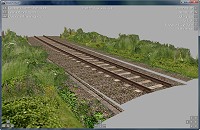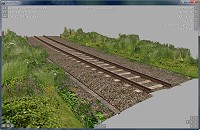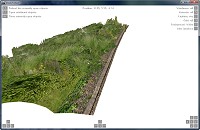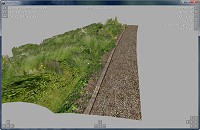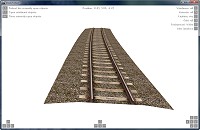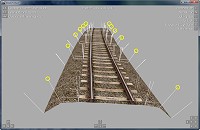- [WJ-R]: 1980s object removal (Castlethorpe/Hanslope area)
- [XCS]: Pending
- [UkTrainSys]: v0.3.2.0 released
- [Object Library]: Preparing...
- [Website]: Fifth version of website launched
 My openBVE videos and other comments from users and
myself can also be found via my YouTube
channel.
My openBVE videos and other comments from users and
myself can also be found via my YouTube
channel.Blog and Progress Updates
April 18, 2019
Watford Junction to Rugby – current progress on 1980s object removal
Posted by admin on April 18, 2019 at 5:23 pmWatford Junction to Rugby – current progress
![]() Firstly, I’d just like to say thank you to everyone whose offered me a warm welcome back to the openBVE scene, it is much appreciated and it’s great to be back! Having looked at some of the newly updated openBVE documentation, I’m looking forward to having a play with some of the new features. Let’s see where we can take openBVE in 2019 🙂
Firstly, I’d just like to say thank you to everyone whose offered me a warm welcome back to the openBVE scene, it is much appreciated and it’s great to be back! Having looked at some of the newly updated openBVE documentation, I’m looking forward to having a play with some of the new features. Let’s see where we can take openBVE in 2019 🙂
Just a quick update on what I’m working on at the moment… As the Watford Junction to Rugby project has developed, I’ve modelled the route with features which occur in two different eras – the 1980s and the 2000s. Such features include signals, gantries, lineside location cases, insulated block joints (IBJs), axle counters, Mk1 and UK1 overhead line equipment, and so-on. The project consists of a “main” routefile at the moment, which includes all of these different-era objects. My current task towards getting the route closer to a release is to hide the 1980s-only objects from the route, leaving just the 2000s objects visible. Here’s a before and after screenshot showing an example of the changes:
The location is between Linslade and Soulbury (south of Bletchley), so I’m making good progress. I have finished inserting the commands and beacons for the UkTrainSys simulation of the Automatic Warning System (AWS) and Train Protection and Warning System (TPWS), as well as added beacons for the neutral section Automatic Power Control (APC) magnets. .Section commands have also been added to the corresponding axle counter locations too.
More updates to follow! Take care all 🙂
Tags: openBVE, openBVE Community, Screenshots, Site News, Watford Jn to Rugby
Posted in openBVE, Site News, Uncategorized | 4 Comments »
April 10, 2019
March 12, 2014
Watford Junction to Rugby update, and collaborative project development
Posted by admin on March 12, 2014 at 11:41 pmUpdate on Watford Junction to Rugby project
![]() I’m pleased to say that I resumed development of the Watford Junction to Rugby project recently. Currently I’m working on implementing new .Beacon commands which support the UkTrainSys plugin’s advanced safety system functionality.
I’m pleased to say that I resumed development of the Watford Junction to Rugby project recently. Currently I’m working on implementing new .Beacon commands which support the UkTrainSys plugin’s advanced safety system functionality.
Signalling along the entire 66.5 mile / 107.1 km route has been updated, with all aspects now comprised of animated objects with ground night lighting.
All Automatic Warning System (AWS) magnets are now comprised of beacons simulating the permanent magnets and electro-magnets of the real life system, and sections are now aligned with track circuit breaks and axle counter head locations.
All Train Protection and Warning System (TPWS) induction loops are now simulated with beacons emulating the real life system in terms of induction loop spacing and frequencies.
There are four OHLE neutral sections modelled on the route, and all of these are now updated with UkTrainSys compatible beacons for the Automatic Power Control (APC) permanent magnets both before and after the neutral section, as well as denoting the start and end of the dead section of contact wire itself.
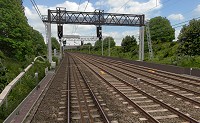 New signals awaiting commissioning (note the out-of-use covers), and modular AWS magnet objects [Click to enlarge] |
Collaborative development
The other significant development, is that the project is now open to third party contributions, to speed up development and bring the release date closer. Ben Leahy is the first developer to contribute to the project by building objects, and I’d be more than happy to hear from you, if you think you’d be able to contribute some more high quality, efficiently coded 3D models for the route, leaving me free to concentrate on the systems and permanent way infrastructure.
Currently there’s a list of objects which need to be created and added to the route. These include:
- Station buildings from Kings Langley through to Rugby inclusive;
- A few lineside buildings, such as houses, warehouses and the like, to be positioned at various locations along the route, but especially at Roade, Weedon, and Rugby;
- A few road overbridges for the Weedon Line, as well as retaining walls at Weedon;
- Road vehicles for road bridges, and the section of M1 motorway at Watford Gap;
- Passing train objects.
If you think you can contribute any of the above, please get in touch and we can discuss options, and I’ll draw up an effective collaboration plan. Thanks 🙂
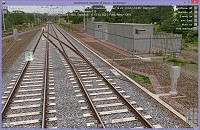 Blisworth pointwork and REBs – can you help by creating a new overbridge object for the site? [Click to enlarge] |
![]() For more information about these ongoing projects:
For more information about these ongoing projects:
 Watford Junction to Rugby Project |
 UK Train System (UkTrainSys) Cross-platform .NET Plugin |
Tags: Animated Objects, Artwork, openBVE, openBVE 2, openBVE Community, Screenshots, Site News, Trackwork, Watford Jn to Rugby
Posted in openBVE, openBVE 2, Site News, Uncategorized | 12 Comments »
November 20, 2010
New cross-platform .NET plugin for UK trains released, class 323 3D cab and Cross-City South v1.31.09 update, openBVE v1.2.9 development branch, .NET plugins and AI support
Posted by admin on November 20, 2010 at 7:30 amNew cross-platform .NET plugin for UK trains (EMUs currently), 323 3D cab / X-City South v1.31.09 updates, and openBVE v1.2.9 AI support
![]() After the latest development branch of openBVE (v1.2.9 series) was released last month, I started work on a new open source, cross-platform plugin written in C#, which I wanted to be a suitable alternative to the plugin currently used by the class 323 EMU. Simon Gathercole’s UKMUt.dll has served me well since BVE Trainsim 4 was released, but after the latest openBVE developments, I knew the time had come to create a new plugin which could be developed to take advantage of the new possibilities which openBVE now provides. I also wanted to create a plugin which could be updated as openBVE develops, either by myself, or with help from other programmers and developers, so that the community doesn’t need to experience plugin-related problems for too long.
After the latest development branch of openBVE (v1.2.9 series) was released last month, I started work on a new open source, cross-platform plugin written in C#, which I wanted to be a suitable alternative to the plugin currently used by the class 323 EMU. Simon Gathercole’s UKMUt.dll has served me well since BVE Trainsim 4 was released, but after the latest openBVE developments, I knew the time had come to create a new plugin which could be developed to take advantage of the new possibilities which openBVE now provides. I also wanted to create a plugin which could be updated as openBVE develops, either by myself, or with help from other programmers and developers, so that the community doesn’t need to experience plugin-related problems for too long.
This new plugin is called UkTrainSys (short for UK Train System of course); it is modular in design, and aims to simulate a variety of systems that trains which run on the UK’s rail network may be equipped with. Initially, I’m working to recreate as much of the functionality found in Simon Gathercole’s range of BVE 4 plugins as necessary, although some new features are included as well. So far, the plugin features the following:
- Automatic Warning System (AWS);
- Train Protection and Warning System (TPWS);
- Driver Reminder Appliance (DRA);
- Vigilance Device;
- Traction and brake interlocks;
- Battery which can be discharged, recharged and overloaded;
- Overhead supply;
- Pantograph and vacuum circuit breaker;
- Automatic Power Control;
- Power supply and electrical system circuit breakers (more for future use);
- In-cab blower;
- Head and tail lights;
- AI guard for station stop monitoring and buzzer codes;
- AI Support which assists openBVE’s AI human driver in handling systems simulated by the plugin automatically
(including support for visible in-cab driver’s hands and arms).
Note: Wipers, windscreen rain effects and diesel engine simulation are yet to be started. I’m also planning for various other systems to be inlcuded in future, such as TPWS+ (TPWS Plus), RETB, ERTMS, random failures, and a tap changer.
Users of trains which include plugins developed for BVE 4, will likely know that when openBVE’s AI human driver is enabled, the AI driver may not always be able to operate a plugin enabled train correctly, simply because openBVE has no way of knowing what systems are simulated by a plugin, and even if openBVE did know what systems were simulated, it still wouldn’t know what to do with them. Hence, the new UkTrainSys plugin uses openBVE v1.2.9’s AI Support feature, which lets the plugin assist openBVE’s AI human driver with operating the systems which are simulated by the plugin.
When you start a route, and enable openBVE’s AI human driver by pressing Ctrl+A, while using the latest release of the class 323’s 3D cab in combination with the UkTrainSys plugin (see below for the download), you will see the AI driver’s arms and hands reach out for the controls, and interact with them whenever necessary. The AI human driver will run through the startup and self-test procedure for you, pressing the AWS reset button, raising the pantograph if required, and setting the taillights and headlights. The plugin takes the time-of-day into account, so the correct headlight setting is chosen based upon the in-game time (and updated as the day goes on). The AI driver will deactivate the DRA before departure, respond to the guard’s buzzer signal with a buzzer response, cancel AWS warnings as they occur, respond to TPWS brake demands, re-raise the pantograph if it is lowered mid-journey, and so-on. The UkTrainSys plugin’s AI Support will also respond to a new beacon type, which instructs the AI driver to blow the horn at certain locations.
Issues with TPWS Isolation, and the driver’s arms remaining visible after turning off openBVE’s AI driver, are hopefully resolved…

I’ve updated the class 323’s 3D cab with new animations which require the UkTrainSys plugin (now included in the download), and I’ve also equipped Cross-City South v1.31 with the aforementioned new beacon type, so the AI driver can sound the horn automatically.
- The updated 323 3D cab and pre-configured UkTrainSys plugin can be downloaded here [2.3 MiB]
(The unrefurbished class 323 from Trainsimcentral is required first – the 3D cab and plugin update should OVERWRITE any existing files in the “Cl323 Unrefurb_openbve” folder). - If you are already using Cross-City South v1.31.071, you can download a small update to v1.31.09 link out of date [95 KiB]
If you don’t already have the route, aren’t sure which release of Cross-City South v1.31 you already have, or want to see details about the latest changes, please download the full version and visit the Cross-City South v1.31 project page instead.
The UkTrainSys plugin also has it’s own project homepage, where just the plugin, source code, current and planned feature list, changelog and documentation can be found. Train developers with an interest is using the UkTrainSys plugin, now or in future, may wish to visit the following page and read the documentation.
Note: If you have downloaded the updated class 323’s 3D cab with the pre-configured UkTrainSys plugin, remember that you should not overwrite the UkTrainSys.cfg file included with the class 323 3D cab update!
 UK Train System (UkTrainSys) Cross-platform .NET Plugin [Alpha release now available] |
I’ve also been working on some new backdrops for both Cross-City South v2.0 and Watford Junction to Rugby. I was happy with the daytime backdrops which you’ve all seen already, but the sky portions of the last set of sunset and sunrise backdrops were entirely hand-made (replacing low resolution BVE4-era images), and I wanted to replace these with photographic textures of a similar quality to the daytime backdrops instead. Fortunately, there as been some favourable weather during the past few days, so I was able to take some nice photographs. Here are the new sunrise and sunset scenes, shown with the 323’s latest 3D cab update, and the openBVE v1.2.9 / UkTrainSys plugin enabled AI support feature in use:
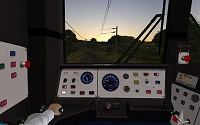 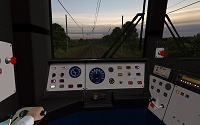 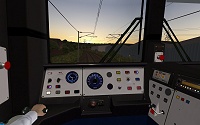 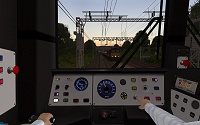 |
Recent openBVE v1.2.9 development branch updates
![]() Towards the beginning of the November, openBVE v1.2.9.11 was released (now up to v1.2.9.15), and Michelle introduced a new set of experimental preprocessing directives. These take the form of $if(), $else() and $endif(), and obviously, these allow for conditional parsing of blocks of code within a route file. This can be an alternative means of achieving what can be accomplished with the $Include directive, which is handy when only a small block of code needs to be conditional.
Towards the beginning of the November, openBVE v1.2.9.11 was released (now up to v1.2.9.15), and Michelle introduced a new set of experimental preprocessing directives. These take the form of $if(), $else() and $endif(), and obviously, these allow for conditional parsing of blocks of code within a route file. This can be an alternative means of achieving what can be accomplished with the $Include directive, which is handy when only a small block of code needs to be conditional.
Personally, I’m finding this very handy for such features as temporary speed restrictions (TSRs). In this scenario, I can randomly introduce TSRs at different locations, so routes can be rather more fun to drive. At the start of the file, we can declare a variable $Sub(0), which has a random number assigned from within a certain range, and then use the value stored in $Sub(0) as a condition which is used by $if() directives. If the value held by $Sub(0) is zero, then the code within any $if() block which depends upon this variable is not used, but if the value is greater than zero, then it is. By using the $else() directive, we can show something else if the TSR is not to be included, such as discarded sections of old rail, left there by the track workers after they made their repairs and removed the TSR. Spate indicators could be handled in a similar way.
For example:
$Sub(100) = $Rnd(0;1)
With Structure
.FreeObj(0) tsr_warn_20mph.csv
.FreeObj(1) tsr_20mph.csv
.FreeObj(2) tsr_terminate.csv
.FreeObj(3) discarded_rail_sections.csv
.FreeObj(4) track_workers.csv
.Beacon(0) portable_aws_magnet.csv
With Route
; Enclose the route commands related to a TSR within $if()/$else()/$endif() directives…
$if($Sub(100))
3000, .Beacon 44001;0, ; portable AWS magnet
$endif()
$if($Sub(100))
3183, .Freeobj 0;0, ; 20 mph TSR advanced warning board
$endif()
$if($Sub(100))
4200, .Freeobj 0;1, .Limit 33;0, ; commencement of 20 mph TSR
$else()
4305, .Freeobj 0;3;5, ; no TSR so show discarded old rails instead
$endif()
$if($Sub(100))
4400, .Freeobj 0;2, .Limit 97;0, ; termination of TSR
$endif()
It’s also possible to use these new preprocessing directives elsewhere in the route file. For example, a different object could be assigned to a free object index, depending upon a condition being true. You can also nest these new preprocessing directives; i.e. place $if/$else()/$endif() selection statements within other selection statements, for example:
$if($Sub(100))
4200, .Freeobj 0;1, .Limit 33;0, ; commencement of 20 mph TSR
$if($Sub(101))
4205, .Freeobj 0;4;-4, ; track workers shown based upon another $Sub variable but only if the TSR is shown
$endif()
$else()
4305, .Freeobj 0;3;5, ; no TSR so show discarded old rails instead
$endif()
Support for these new preprocessor directives is still experimental, and not guaranteed to be included in the next stable release of openBVE, however I’ve not encountered a problem with the feature thus far, at least with regard to the things I’d like to use the feature for, and it’s really very easy to use. Some more testing would be beneficial, but I hope the feature stays, and I’ll certainly be making use of it if it does.
Other news – Chashinai .NET plugin updated with AI support, new Network West Midlands video, and FEVF railway updates
![]() In case you weren’t aware, the new cross-platform .NET plugin which is used by the trains which run on the Chashinai Railway, was updated earlier this month to include AI support, which is a lot of fun, especially with the Chashinai 9000 series train complete with ATS-Sn, ATS-P, ATC and TASC. As with the new UkTrainSys plugin, the updated Chashinai Railway plugin’s AI support assists openBVE’s AI human driver in operating the safety systems, so you can enable the AI human driver and even watch the startup procedures handled by the AI driver. The plugin source code is available as well, of course.
In case you weren’t aware, the new cross-platform .NET plugin which is used by the trains which run on the Chashinai Railway, was updated earlier this month to include AI support, which is a lot of fun, especially with the Chashinai 9000 series train complete with ATS-Sn, ATS-P, ATC and TASC. As with the new UkTrainSys plugin, the updated Chashinai Railway plugin’s AI support assists openBVE’s AI human driver in operating the safety systems, so you can enable the AI human driver and even watch the startup procedures handled by the AI driver. The plugin source code is available as well, of course.
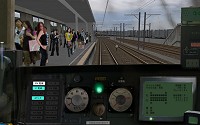 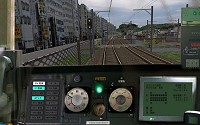 Chashinai Railway Takahagi Line (9000 series train, ATS-P, AI driver enabled) |
I also wanted to quickly mention that Steve Green has posted a short YouTube video of the upcoming Network West Midlands 2010 update, demonstrating animated level crossing barriers interlocked with the signalling, together with updated objects such as a new AWS magnet, which I thought looked really good:
Several other videos of the upcoming NWM release can also be found on Steve’s YouTube channel, and screenshots can be found on the Network West Midlands website.
Lastly, I wanted to show something a little bit different – Roberto Benini, developer of the FEVF (Ferrovia Elettrica Val di Fiemme) railway, has released an animated Mallet Henschel & Sohn 6036 steam loco for openBVE, which is well worth a look, and I noticed that the FEVF Railway itself now has some moving trains at Cavalese station too. The route and train can be downloaded here:
Roberto Benini has also posted a YouTube video of the new loco:
Tags: Animated Objects, Artwork, Cross-City South, Functions, openBVE, openBVE Community, Screenshots, Site News, Software, Watford Jn to Rugby
Posted in openBVE, Site News | 13 Comments »
October 14, 2010
September 5, 2010
July 11, 2010
openBVE v1.2.7.0 released, new Railsimroutes.net site design, Cross-City South v1.31.07 and miscellaneous project updates, Watford Junction to Rugby screenshot featured in the UK’s PC Gamer Magazine, Genova Brignole – Recco route (as far as Genova Nervi) released
Posted by admin on July 11, 2010 at 6:00 amopenBVE v1.2.7.0 released
![]() Today sees the release of openBVE v1.2.7.0, and some interesting changes have taken place. To begin with, the handling of key and joystick buttons has been revised, and key repeat is now possible. This means that you can hold a key down, and after a short delay, the keypress will be repeated continuously until the key is released again. I’m glad that openBVE now supports this functionality, and this is great for quickly moving a power handle to the limit of it’s travel without having to keep tapping the key, or for sounding the horn in a long and loud fashion, for example. The fly-by camera has also been improved, and now, the leading vehicle (of the nearest train) is tracked by the camera, which is great for loco-hauled trains in particular. 🙂
Today sees the release of openBVE v1.2.7.0, and some interesting changes have taken place. To begin with, the handling of key and joystick buttons has been revised, and key repeat is now possible. This means that you can hold a key down, and after a short delay, the keypress will be repeated continuously until the key is released again. I’m glad that openBVE now supports this functionality, and this is great for quickly moving a power handle to the limit of it’s travel without having to keep tapping the key, or for sounding the horn in a long and loud fashion, for example. The fly-by camera has also been improved, and now, the leading vehicle (of the nearest train) is tracked by the camera, which is great for loco-hauled trains in particular. 🙂
Superelevation is now simulated differently as well; in previous versions, when cant was applied, the train would simply rotate around it’s z-axis, but now, the outer wheel is raised instead. Cant is also interpolated better now, leading to smoother transitions between differing levels of cant. I’m currently rebuilding the canted track objects used by my routes to make better use of these openBVE improvements, such that the wheels will remain on the rails when passing along superelevated track, and the cant transitions at either end of such sections:
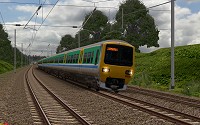 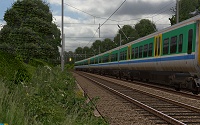 Screenshot showing superelevation in openBVE v1.2.7.0 and Cross-City South v2.0. Note the wheels touching the rails throughout the transition curve (scenery is not finished yet). |
Cant behaviour can also be adjusted now, via the new 'Options.CantBehavior' command. Previously, cant was always applied towards the curve centre, i.e. banking inwards, and this couldn’t be overidden. Also, it wasn’t possible to have cant on straight track. Now though, cant be in either direction, regardless of the direction of the curve, and cant can be applied on straight track too. How might this be useful for simulating a real railway? Well, on the 11th July last year (exactly a year ago as it happens), I was unexpectedly invited for a visit to the preserved Gloucestershire and Warwickshire Railway, and this line has a curve known as Chicken curve, and one peculiar feature was that the cant at this location leaned outward from the curve rather than inwards. So, openBVE can simulate this too, now. Class 20 “chopper” (20154) was our traction on the day, and here’s a photo for fans of the class 20, which I took before we departed from Toddington:
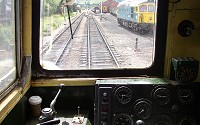 In the cab of a class 20 loco at Toddington, on the preserved Gloucestershire and Warwickshire Railway. |
The simulation of track inaccuracy has been overhauled, too. Previously, the familiar cab and vehicle sway was achieved with horizontal and vertical movement, but now, cant inaccuracy and bounce is also modelled, and cars rock from side to side as well as moving vertically and horizontally. While we were testing the new inaccuracy model, I found that this was an interesting way to represent the effect of travelling over more poorly maintained jointed rails. I’ve made some adjustments to the track accuracy in the newly udpated Cross-City South v1.31.07 (see below for download), and travelling over pointwork or on the jointed rail sections of the Cross-City South, should be a little more interesting now, especially when the class 323’s 3D cab is used. 🙂
Essentially, I think .Accuracy values of 0 to 2.0 are suitable for continuous welded rail, and values of 2.1 to 4 are suitable for jointed rails. I’m aware that not everyone may be sure about the new inaccuracy model, however I think it works well when used sensibly, and I would also point out that the development release has been publicly available for testing for at least three weeks, so if you don’t like it, you’ve missed your chance to give feedback prior to the latest stable release. Nevertheless, if you have any comments, please let us know. Personally I prefer the new algorithm and enjoy the representation it can give when accompanied by the sounds of jointed rails, but some may prefer the old; please give it a try with the updated Cross-City South v1.31.07 and class 323 3D cab though (see below), as this update shows what the new inaccuracy model can do. Also bear in mind that you may only prefer the old algorithm because you’re used to it, not because it was more realistic; the old algorithm had it’s limitations.
Also, BVE4 style timetable textures can now be displayed when 3D cabs are used, and not just with legacy 2D panels, although this is considered an experimental feature. The timetable texture can be shown as part of the in-game user interface overlay, or as part of a 3D cab (animated object); if the latter is not specifically catered for within the 3D cab, then the former is the default behaviour. Adding BVE4 style timetables to a 3D cab is easy to do; I would recommend simply creating an object with a four-vertex mesh and default texture applied (which is shown if there is no timetable image to display), and add this object to your panel.animated file. Then, make use of the new 'TextureOverride =' command:
CreateMeshBuilder
AddVertex,-0.35,2.9,11.52
AddVertex,-0.06,2.9,11.52
AddVertex,-0.06,2.6,11.52
AddVertex,-0.35,2.6,11.52
AddFace,0,1,2,3
LoadTexture,some_suitable_default_texture.png
SetTextureCoordinates,0, 0, 0
SetTextureCoordinates,1, 1, 0
SetTextureCoordinates,2, 1, 1
SetTextureCoordinates,3, 0, 1
[Object]
States = 3d_cab\timetable.csv
TextureOverride = timetable
I’ve added the aforementioned timetable functionality to the class 323’s 3D cab, but it’s commented out by default, as displaying the timetable images via openBVE’s UI overlay makes more sense where the Cross-City South and class 323 are concerned, plus the feature is still experimental.
You can download the update here, and if you want to experiment with the 'TextureOverride =' command, please see the included ‘Readme_3DCab.txt’ file:
→ 3D cab for unrefurbished class 323 – July 2010 [1.7 MiB]
For more detailed information about the new cant behaviour, and timetable support in .animated objects, please read the official openBVE documentation. For details of all the changes introduced with the v1.2.7.0 release of openBVE, including those not mentioned here, please see the changelog.
Cross-City South v1.31.07 update
![]() As openBVE v1.2.7.0 has been released, I’ve updated Cross-City South v1.31 to remove an obsolete timetable texture, changed some of the timetable images to make them suitable for both openBVE and BVE4, and made adjustments to track inaccuracy to take better advantage of openBVE v1.2.7.0’s new track inaccuracy model. I’ve renamed the route folders to more clearly indicate which sets of routes should be used with openBVE, BVE 4 or BVE 2, as well. I’ve also decided to finally split the openBVE routes away from the BVE 4 routes, as testing every openBVE improvement across numerous route files for 100% backwards compatibility with BVE 4 is somewhat inconvenient, and this also lets me get rid of all those pesky "detail levels" in the openBVE route folder, as these simply aren’t needed with openBVE. The new naming convention is as follows, and should be much clearer (the BVE 2 foldername is as it is, so it’ll fit within the size constraints of BVE 2’s small file selection list):
As openBVE v1.2.7.0 has been released, I’ve updated Cross-City South v1.31 to remove an obsolete timetable texture, changed some of the timetable images to make them suitable for both openBVE and BVE4, and made adjustments to track inaccuracy to take better advantage of openBVE v1.2.7.0’s new track inaccuracy model. I’ve renamed the route folders to more clearly indicate which sets of routes should be used with openBVE, BVE 4 or BVE 2, as well. I’ve also decided to finally split the openBVE routes away from the BVE 4 routes, as testing every openBVE improvement across numerous route files for 100% backwards compatibility with BVE 4 is somewhat inconvenient, and this also lets me get rid of all those pesky "detail levels" in the openBVE route folder, as these simply aren’t needed with openBVE. The new naming convention is as follows, and should be much clearer (the BVE 2 foldername is as it is, so it’ll fit within the size constraints of BVE 2’s small file selection list):
- <YourPath>\Railway\Route\Bham_XCitySouth_BVE2\
- <YourPath>\Railway\Route\Birmingham_Cross-City_South_BVE4\
- <YourPath>\Railway\Route\Birmingham_Cross-City_South_openBVE\
Cross-City South v1.31.05 users can download a smaller update here, which updates v1.31.05 to v1.31.07:
→ v1.31.07 update for existing Cross-City South v1.31.05 users [1.03 MiB]
If you have an earlier version of Cross-City South installed, or you’re not sure which version you already have, please download the full version instead.
Genova Brignole – Recco route (as far as Genova Nervi thus far) for openBVE released
![]() I wanted to mention that a fantastic new route has been released for openBVE, the Italian Genova Brignole – Recco route (as far as Genova Nervi thus far, and 8.1 Km in length). This is one of the most graphically excellent routes I’ve seen to date, with superb textures, and I’m impressed; the route is beautiful. There are some animated objects to enjoy, and staggered catenary as well, which is great to see; pedantic people like me will note that some registration arms pull in the wrong direction, though. 😉
I wanted to mention that a fantastic new route has been released for openBVE, the Italian Genova Brignole – Recco route (as far as Genova Nervi thus far, and 8.1 Km in length). This is one of the most graphically excellent routes I’ve seen to date, with superb textures, and I’m impressed; the route is beautiful. There are some animated objects to enjoy, and staggered catenary as well, which is great to see; pedantic people like me will note that some registration arms pull in the wrong direction, though. 😉
You’ll likely need to read the included PDF instructions before operating the newly released ALn501 – Minuetto v2 train, but it’s well worth the effort. Incidentally, the train comes with some very detailed exterior car objects. These look very nice, although they would benefit from the addition of custom normals to smoothly shade some of the surfaces. Please note that these exterior car objects may have quite an impact on your framerate; even on my Core 2 Quad Q9650 / GeForce GTX 260 system, I get around 30fps in the external view, which is down from anywhere between 80 – 300 fps in the cab view. If you have a slow PC, you may want to stay in the cab. I’m looking forward to seeing this route develop further. 🙂
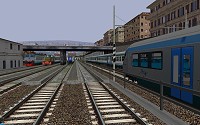 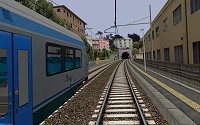 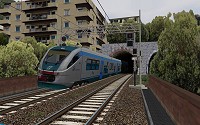 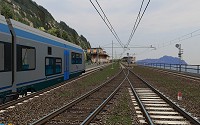 The Italian Genova Brignole – Recco route (as far as Genova Nervi thus far), available from BVEMania (Trenomania) (see the Download section) |
Miscellaneous news
![]() I’m officially announcing the Railsimroutes.net UK Railway Infrastructure Object Library today, which will contain all the objects and textures which are shared between my two upcoming openBVE route projects, Birmingham Cross-City South v2.0, and Watford Junction to Rugby v1.0. This library will be maintained by me, and all developers will be welcome to install and use this library with their own projects, without any conditions or requirement to seek permission.
I’m officially announcing the Railsimroutes.net UK Railway Infrastructure Object Library today, which will contain all the objects and textures which are shared between my two upcoming openBVE route projects, Birmingham Cross-City South v2.0, and Watford Junction to Rugby v1.0. This library will be maintained by me, and all developers will be welcome to install and use this library with their own projects, without any conditions or requirement to seek permission.
The library will contain all sorts of objects, including track, catenary, signals, lineside objects, some basic scenery, and so-on, which might help to make new routes easier to develop. It will also have the advantage, that whenever I update the library, perhaps with higher quality textures or better objects, any routes which call upon the library, will also get updated. I’ll plan it carefully, to ensure that changes remain backwards compatible. I anticipate that the library will be released along with Cross-City South v2.0 initially, and then it’ll receive it’s first update when Watford Junction to Rugby is ready.
 UK Railway Infrastructure Object Library [Now in development] |
Next, as you may have noticed, I’ve decided to increase the version number of my upcoming Cross-City South upgrade for openBVE, from version 1.4, to version 2.0. I think I’m making enough changes and enhancements to the route, to justify a version 2.0 release instead. 🙂
I’ve also updated the openBVE Help and Information section to cover the installation of openBVE in Ubuntu 10.04 (Lucid Lynx). It’s hard to imagine how installing openBVE via the Ubuntu Software Centre could be any easier, and installing openBVE via this method, also makes installing and running the latest official openBVE release with Mono, easier too. I’ve decided to remove the instructions explaining how to run openBVE with Wine, as I’m experiencing problems with the version of Wine available for install with Ubuntu 10.04, relating to GDI+ (and the problem isn’t just occurring with openBVE, either). Perhaps something to do with a Beta release of Wine being supplied rather than a stable release, I don’t know. Running with Mono is much easier though, if you can live without plugin DLLs.
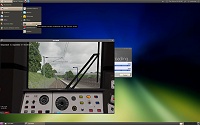 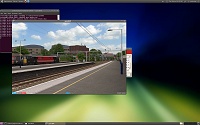 openBVE Help and Information updated for Ubuntu 10.04 users |
I was lucky enough to have one of my screenshots published in the July issue of the UK edition of PC Gamer magazine, where I also gave a brief overview of the work being undertaken on openBVE 2. I will admit that it was nice to handle such a press enquiry! Here’s the screenshot which was chosen for the article, shown amongst screenshots of various simulators, such as Railworks, X-Plane, Sail Simulator, Space Shuttle Mission Simulator, and others:
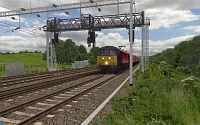 The Watford Junction to Rugby screenshot chosen to appear in simulation article “The Realists”, in the July 2010 issue of the UK edition of the best selling PC Gamer magazine. |
Incidentally, I also want to apologise for the lack of progress with my routes, and for posting so many screenshots and not delivering anything, which I feel that some of you are not impressed by. This is mainly due to me working on openBVE 2, which means that I don’t have much time to devote to the routes at the moment. openBVE 2 is a priority though, and a fantastic experience for me, so I hope fans of my routes will understand. Besides, both routes will run even better in openBVE 2, anyway. I know that the routes look more-or-less finished already, but they’re not – there are such issues as missing track in places, performance optimisations which still to be carried out, and an entire missing station to deal with at Rugby, to name but a few examples. I don’t make a habit of releasing junk and expecting people to be happy with it, so the projects won’t be released until I’m satisfied that a decent standard of quality has been achieved; that doesn’t mean they have to be perfect in every way, just not a disappointment.
New Railsimroutes.net site design
![]() As regular visitors will have hopefully noticed, I’ve redesigned the website, as I felt it needed an update, and I also wanted to put some updated website design skills into practice. The site was last redesigned in 2007 with a theme called “Modern”, characterised by a metallic grey colour scheme and smoothly shaded backgrounds, where Windows users would have been greeted with the Tahoma font throughout, and it was designed to be XHTML 1.0 and CSS Level 2 compliant. However, the content of the site wasn’t reorganised very much since the time of the previous “Retro Blue” design, and over time it became somewhat cluttered and untidy in my view.
As regular visitors will have hopefully noticed, I’ve redesigned the website, as I felt it needed an update, and I also wanted to put some updated website design skills into practice. The site was last redesigned in 2007 with a theme called “Modern”, characterised by a metallic grey colour scheme and smoothly shaded backgrounds, where Windows users would have been greeted with the Tahoma font throughout, and it was designed to be XHTML 1.0 and CSS Level 2 compliant. However, the content of the site wasn’t reorganised very much since the time of the previous “Retro Blue” design, and over time it became somewhat cluttered and untidy in my view.
This latest redesign is the fourth incarnation of the site, with a new theme called “Clarity” (hopefully it might live up to it’s name ;)). The new design is meant to be clearer, better organised, and easier to read. The site has been completely rebuilt from scratch; PHP is now used as well as HTML, and much of the site is XHTML 1.1 and CSS Level 3 compliant. I’ve tested the new site using Firefox 3, Internet Explorer 8, Opera 10, Chrome 5, and Safari 5, and everything works well. The site also works just fine in Internet Explorer 7 and earlier too (tested as far back as IE 5.5), but if you use one of those older Microsoft browsers, you might notice a minor rendering issue around the style selector dropdown box in the footer of each page. Essentially, I’m not happy having to devote much time to dealing with the quirks of browsers which aren’t properly compliant with more recent web standards, partly because it’s just annoying, but also because catering for them can lead to such browsers outliving their welcome (IE 6 springs to mind!). So, if you use Internet Explorer 7 or earlier and want perfect rendering, I would recommend upgrading to Internet Explorer 8 if possible, which is just fine.
I’ve also decided to reorganise the content of the site somewhat. The navigation bar has been expanded with the addition of Gallery and Help links, and the Projects and Downloads section has been overhauled to place emphasis on active projects, and non-help related information. Much more background information and history concerning my route projects is provided now, and information and downloads should be easier to find when they’re ready for release. You’ll also find a "What I’m currently working on" infobox at the top right of this page, which you can check to see what I’m up to, between blog posts. 🙂
I’ve taken the decision to remove some old sections of the site which never received much of my attention, and I’ve moved my old BVE 2 and 4 add-ons into their own de-emphasised legacy add-ons section, as they’re not really reflective of the quality of work I’m now producing; the emphasis is now placed on my upcoming openBVE projects instead. I’ve also introduced a sitemap, as a couple of people have indicated that some information was harder to find, previously.
I’ve also used a different selection of fonts this time:
- Windows 7 and Vista users will get the Segoe UI font throughout (along with the rather nice Consolas for code snippets), giving the best appearance.
- Windows XP users will also get the Segoe UI font, if Windows Live Essentials applications have been installed (for example, Messenger, Mail, Photo Gallery or Writer), or if Office 2007/2010 has been installed. XP users will also get the Consolas font with Office 2007/2010, or this can be downloaded free from Microsoft’s website. If neither Windows Live Essentials or Office 2007/2010 have been installed, but the free Microsoft Powerpoint Viewer 2007 is installed, then Candara (along with Consolas) will be seen instead. If none of these have been installed, then Trebuchet MS (along with Courier New for code snippets) will be seen, which are fonts included with Windows XP.
- Others will likely see generic sans serif and monospace fonts (although these look very nice in Ubuntu Linux, for example).
Incidentally, I experimented with CSS3’s @font-face declaration for embedding fonts, so that a consistent text style would be seen regardless of which fonts are installed locally on someone’s computer. This does indeed work fine, but I haven’t yet decided upon a set of fonts which I like, and which are also released with acceptable non-restrictive licencing terms, so that I can host the fonts on my own server without issues. I’ll explore this again in future, however.
More observant visitors will have noticed that I’ve also renamed the site slightly. I’ve dropped the “UK” part of “Rail Sim Routes UK”, and the site is now called “Railsimroutes.net” instead. The site is still available via two domain names, railsimroutes.net and railsimroutes.co.uk; I have no plans to retire the .co.uk domain, although you might want to update your bookmarks if you still use it.
Anyway, I hope you like the new Railsimroutes.net design. 🙂
Tags: Animated Objects, Artwork, Cross-City South, Functions, openBVE, openBVE 2, openBVE Community, Screenshots, Site News, Watford Jn to Rugby
Posted in openBVE, openBVE 2, Site News | 34 Comments »
May 14, 2010
Animated digital station clocks for openBVE, and 3D cab for 1992 stock released at BVE Routes & Trains
Posted by admin on May 14, 2010 at 6:50 amAnimated digital station clocks
![]()
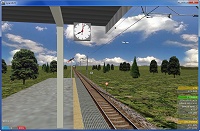 I’m not sure if any other openBVE developers have attempted this yet, but a feature I’ve been wanting to add to my routes for some time now, is animated digital station clocks which show the actual in-game time. Of course, we’ve seen a very nice working analogue station clock featured in » DemoRoute1 « (see right), but a digital clock would be useful, too.
I’m not sure if any other openBVE developers have attempted this yet, but a feature I’ve been wanting to add to my routes for some time now, is animated digital station clocks which show the actual in-game time. Of course, we’ve seen a very nice working analogue station clock featured in » DemoRoute1 « (see right), but a digital clock would be useful, too.
I studied the functions in DemoRoute1’s analogue clock .animated file, along with openBVE 1’s source code to see how the display of in-game time is handled, and eventually opted to use multiplication rather than division in my functions as per the animated object in DemoRoute1. You can find some details of the finished set of files below.
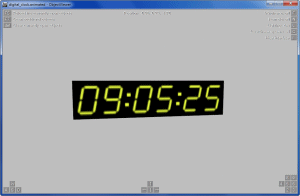 Animated 24-hour digital clock shown in the openBVE Object Viewer utility. Sample files can be downloaded here. |
Please feel free to download and use the above files if you’d like to adapt them for your own route, all you need to do is create an enclosure for the digits, and translate or resize the digits, to suit your own needs. The digital clock consists of an object which shows a single digit from a texture containing a strip of digits from 0-9, a separator, and a black background. The .animated file is as follows:
[Object]
States = back.csv
Position = 0, 0, 0
; Hours
[Object]
States = digit.csv
Position = -0.51, 0, 0
TextureShiftYFunction = 0.1 * floor[mod[time * 0.000277777777777778, 24] * 0.1]
[Object]
States = digit.csv
Position = -0.33, 0, 0
TextureShiftYFunction = 0.1 * floor[mod[time * 0.000277777777777778, 24]]
[Object]
States = digit_separator.csv
Position = -0.21, 0, 0
; Minutes
[Object]
States = digit.csv
Position = -0.09, 0, 0
TextureShiftYFunction = 0.1 * floor[mod[time * 0.0166666666666667, 60] * 0.1]
[Object]
States = digit.csv
Position = 0.09, 0, 0
TextureShiftYFunction = 0.1 * floor[time * 0.0166666666666667]
[Object]
States = digit_separator.csv
Position = 0.21, 0, 0
StateFunction = value == 0
RefreshRate = 0.5
; Seconds
[Object]
States = digit.csv
Position = 0.33, 0, 0
TextureShiftYFunction = 0.1 * floor[mod[time, 60] * 0.1]
[Object]
States = digit.csv
Position = 0.51, 0, 0
TextureShiftYFunction = 0.1 * floor[time]
Note: The purpose of the mod[] function used in displaying the hour digits, is to ensure that the displayed time wraps around back to 00 when passing midnight, rather than 24 or higher being displayed.
Here’s a screenshot of the above working digital clock, adapted for use in a prototypical structure at Kings Langley on the Watford Junction to Rugby route; note the displayed time on the clock, matching the in-game time shown at the bottom left of the screen:
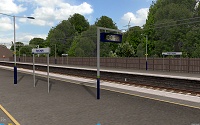 openBVE / Watford Junction to Rugby screenshot showing animated digital clock — click to enlarge Note: Station nameboard textures created using » Station Nameboard Generator v2 « |
3D cab for 1992 stock released
![]() I also just wanted to briefly mention that a new openBVE 3D cab has been released for the London Underground 1992 stock, with animated features including a traction/brake controller, speedometer, and working in-cab CCTV monitor. Night-illuminated cab indicators and screens are also included, and the overall effect created by the cab is very nice, despite a couple of initial teething problems. The 3D cab is an add-on for the BVE4 1992TS, which needs to be installed first; both downloads can be found at » http://bveroutes-trains.co.uk «. A note on installing the 3D cab — at the time of writing, I noticed that the 3D cab download contains an incorrect folder structure, i.e. there’s no “1992TS” subfolder included, and the files could easily end up accidentally being placed in your Train folder directly instead, which won’t work, of course. You will need to be careful as to where you choose to extract the files. For further information, you might like to monitor » this thread « on the BVE Exchange forum.
I also just wanted to briefly mention that a new openBVE 3D cab has been released for the London Underground 1992 stock, with animated features including a traction/brake controller, speedometer, and working in-cab CCTV monitor. Night-illuminated cab indicators and screens are also included, and the overall effect created by the cab is very nice, despite a couple of initial teething problems. The 3D cab is an add-on for the BVE4 1992TS, which needs to be installed first; both downloads can be found at » http://bveroutes-trains.co.uk «. A note on installing the 3D cab — at the time of writing, I noticed that the 3D cab download contains an incorrect folder structure, i.e. there’s no “1992TS” subfolder included, and the files could easily end up accidentally being placed in your Train folder directly instead, which won’t work, of course. You will need to be careful as to where you choose to extract the files. For further information, you might like to monitor » this thread « on the BVE Exchange forum.
![openBVE / 1992 Stock thumbnail image [Click to enlarge] Screenshot](/images/thumbnails/1992stock_openbve_1.jpg) openBVE / 1992 Stock screenshot » Download from http://bveroutes-trains.co.uk « |
Tags: Animated Objects, Functions, openBVE, openBVE Community, Screenshots, Watford Jn to Rugby
Posted in openBVE | 8 Comments »
April 14, 2010
Chashinai Railway April updates
Posted by admin on April 14, 2010 at 12:30 am![]() What I would consider to be one of the flagship routes for openBVE due to it’s innovation, and one of the most varied and enjoyable, namely » odakyufan’s Chashinai Railway «, has been updated. The Misaki Line from Tawaramoto to Hitachiomiya can now be driven back and forth in both directions (via seperate route files), which is fun. The ATC system has also been redesigned, such that a gradual, smooth brake curve is now implemented, along with a Rapid Mode which removes the smoothening for use in the rush hour where trains are more frequent and adhering to the timetable is harder. Driving the Chashinai 9000 Series train with ATC, TASC and ATO activated is one of the most enjoyable things which can be done with openBVE, so I’d strongly recommend that you give this a try — it’s well worth it. Instructions can be found » here «. Please also note that the source code for the plugins used by the Chashinai Railway’s trains is included within the train download, and I’d recommend that anyone considering plugin development in future, study the cleanly written, concise source code as well, of course bearing in mind that a move to cross-platform .NET plugins will occur in future. Incidentally, publishing the source code for plugins is something I would like to see more train developers doing in future, and certainly something I will be doing in future (I’ll be writing a new cross-platform .NET plugin for the new class 323 of course), once » openBVE 2 « is in a more advanced stage of development.
What I would consider to be one of the flagship routes for openBVE due to it’s innovation, and one of the most varied and enjoyable, namely » odakyufan’s Chashinai Railway «, has been updated. The Misaki Line from Tawaramoto to Hitachiomiya can now be driven back and forth in both directions (via seperate route files), which is fun. The ATC system has also been redesigned, such that a gradual, smooth brake curve is now implemented, along with a Rapid Mode which removes the smoothening for use in the rush hour where trains are more frequent and adhering to the timetable is harder. Driving the Chashinai 9000 Series train with ATC, TASC and ATO activated is one of the most enjoyable things which can be done with openBVE, so I’d strongly recommend that you give this a try — it’s well worth it. Instructions can be found » here «. Please also note that the source code for the plugins used by the Chashinai Railway’s trains is included within the train download, and I’d recommend that anyone considering plugin development in future, study the cleanly written, concise source code as well, of course bearing in mind that a move to cross-platform .NET plugins will occur in future. Incidentally, publishing the source code for plugins is something I would like to see more train developers doing in future, and certainly something I will be doing in future (I’ll be writing a new cross-platform .NET plugin for the new class 323 of course), once » openBVE 2 « is in a more advanced stage of development.
Moving road vehicles have also been added together with traffic sounds, shown to best visual effect on overbridges, I think particularly on the Koriyama Line (also bi-directional), Takahagi and Ishinden Lines, and vehicles can be seen travelling parallel to the railway between Shirosato and Motegi on the Misaki Line as well. The use of texture shifting functions here, enables vehicles to appear as though they’re travelling along the road, despite it’s apparent gradient and directional changes. I’ll be doing something similar at Watford Gap and other locations on the Watford Junction to Rugby route, using a technique developed for 3D vehicles by odakyufan, » details of which can be found here «. Other details, such as beacons correctly aligned with sleepers and track are taken care of too, as I’ve tried to do with AWS magnets in my routes. You’ll also find far more variation in the numbers of passengers waiting to board your train, which makes stations pleasing and fun to approach as there’s far more to see now; the recent changes to openBVE regarding the weight of the train increasing with passenger load and the effect this has on performance, can be used to good effect here (don’t forget to download the most recent version 1.2.6.1 of » openBVE « for this to work). Watch out for wheelslip depending on location, environmental or meteorological conditions too!
Developers might also be interested in taking a look at how the Chashinai Railway’s route files have been prepared. openBVE’s $Include directive has been used extensively, with much greater efficiency and flexibility now possible.
Please visit » The Web Presence of Odakyufan « to download the latest release of Chashinai Railway, and also » this thread on the openBVE forum «, where additional screenshots, information, details and benefts of $Include can be found. This is sophisticated, high quality and beautiful work, and I look forward to seeing more in future.
| Images captured at 1680×1050, with smooth transparency and 16xQ anti-aliasing and 16x anisotropic filtering (Please hover over any thumbnail image for a description) ![About to pick up additional passengers waiting to join the train at Izumozaki North on the Misaki Line, with ATC indicating a clear line ahead. [Click to enlarge] About to pick up additional passengers waiting to join the train at Izumozaki North on the Misaki Line, with ATC indicating a clear line ahead. [Click to enlarge]](/images/thumbnails/openbve_chashinai_17.jpg) ![Animated road vehicles crossing the overbridge at Kawarada station where the Ishinden and Uchiike Lines join together, as the warmth of the rising sun adds ambience to the scene. [Click to enlarge] Animated road vehicles crossing the overbridge at Kawarada station where the Ishinden and Uchiike Lines join together, as the warmth of the rising sun adds ambience the scene. [Click to enlarge]](/images/thumbnails/openbve_chashinai_18.jpg) openBVE / Chashinai Railway screenshots Download from » The Web Presence of Odakyufan « |
Railsimroutes Projects
![]() I know haven’t posted any updates regarding my own projects for some time, about which I can only apologise. I have a couple of features which I want to be working on for » openBVE 2 « first, however when I have time spare I’m also working on implementing another feature for both of my routes, and I’ll post some screenshots of this once I’m happy with how it all looks. More to follow fairly soon…
I know haven’t posted any updates regarding my own projects for some time, about which I can only apologise. I have a couple of features which I want to be working on for » openBVE 2 « first, however when I have time spare I’m also working on implementing another feature for both of my routes, and I’ll post some screenshots of this once I’m happy with how it all looks. More to follow fairly soon…
Tags: Animated Objects, Artwork, openBVE, openBVE Community, Screenshots, Site News, Trackwork, Watford Jn to Rugby
Posted in openBVE, Site News | 1 Comment »
April 7, 2010
Updated openBVE developer tools and openBVE v1.2.6.1, upcoming Network West Midlands updates, upcoming Taipei Metro route for openBVE, and server upgrade
Posted by admin on April 7, 2010 at 6:00 amopenBVE v1.2.6.1 and updated openBVE developer tools
![]() openBVE v1.2.6.1 has been released, which includes a bugfix relating to the Options.UnitOfSpeed command, which could for example, involve an incorrect speed limit being determined when the Route.Limit command is used. Please » download the latest release « if this issue affects you.
openBVE v1.2.6.1 has been released, which includes a bugfix relating to the Options.UnitOfSpeed command, which could for example, involve an incorrect speed limit being determined when the Route.Limit command is used. Please » download the latest release « if this issue affects you.
Also, when I posted my last blog entry, I forgot to mention that the » openBVE Route Viewer « has been updated. When your route is loaded, you can now simply type in a distance via the main number keys (not the numberpad keys), and hit Enter — the camera will then be moved directly to the location you just entered. This is an immensely useful time-saver.
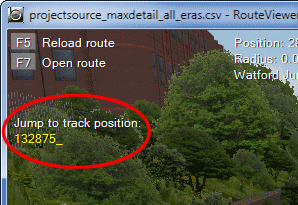 openBVE Route Viewer screenshot — click to enlarge |
Also, when you pass a CSV format route or object file as a command line parameter to either Route Viewer or Object Viewer, the tools will now auto-detect whether the CSV file is a route or an object, and load the appropriate tool automatically. Please see the Tools section within the » Developing for openBVE « pages for more information. For developers who haven’t used the command line for opening routes or objects before, it can be done as follows (obviously replace the path and file names according to your own setup):
| RouteViewer.exe “<YourDrive>:\YourPath\FileName.ext” |
Network West Midlands openBVE updates
![]() The » Network West Midlands « (NWM) team have announced some promising updates for the first 2010 release of the route network, which should make some good use of openBVE’s capabilities and features. We can look forward to such delights as random moving traffic on overbridges, moving passing trains similar to what I’ve demonstrated in one of my early YouTube videos, various points of interest, multiple eras, random routing/weather conditions/other features thanks to openBVE’s » $Include directives «, 3D signals, trees and lamp posts similar to those I’ve shown previously, along with the addition of catenary based on my own high detailed Cross-City South OHLE objects throughout the routes, where a very nice job has been done with their implementation. Some excellent new track textures have also been prepared for the route.
The » Network West Midlands « (NWM) team have announced some promising updates for the first 2010 release of the route network, which should make some good use of openBVE’s capabilities and features. We can look forward to such delights as random moving traffic on overbridges, moving passing trains similar to what I’ve demonstrated in one of my early YouTube videos, various points of interest, multiple eras, random routing/weather conditions/other features thanks to openBVE’s » $Include directives «, 3D signals, trees and lamp posts similar to those I’ve shown previously, along with the addition of catenary based on my own high detailed Cross-City South OHLE objects throughout the routes, where a very nice job has been done with their implementation. Some excellent new track textures have also been prepared for the route.
![Network West Midlands 2010 thumbnail image [Click to visit NWM Website] Screenshot](/images/thumbnails/nwm_openbve_1.jpg) ![Network West Midlands 2010 thumbnail image [Click to visit NWM Website] Screenshot](/images/thumbnails/nwm_openbve_2.jpg) openBVE / Network West Midlands screenshots — click to visit the NWM news page |
Please visit the » NWM website « for more information and screenshots.
Upcoming Taipei Metro route for openBVE
![]() I noticed some new screenshots of the Taipei Metro Xinbeitou Branch Line, being developed for openBVE by » BVETRT «, and I wanted to mention them as I think they look superb. There’s richly coloured scenery, the detailing of the stations and near-track areas looks fantastic, and the railway infrastructure is very well modelled and convincing. Also take a look at this » YouTube video « of the line as well.
I noticed some new screenshots of the Taipei Metro Xinbeitou Branch Line, being developed for openBVE by » BVETRT «, and I wanted to mention them as I think they look superb. There’s richly coloured scenery, the detailing of the stations and near-track areas looks fantastic, and the railway infrastructure is very well modelled and convincing. Also take a look at this » YouTube video « of the line as well.
![Taipei Metro Xinbeitou Branch Line for openBVE - thumbnail image [Click to visit homepage] Screenshot](/images/thumbnails/bvetrt_openbve_1.jpg) ![Taipei Metro Xinbeitou Branch Line for openBVE - thumbnail image [Click to visit homepage] Screenshot](/images/thumbnails/bvetrt_openbve_2.jpg) Taipei Metro Xinbeitou Branch Line for openBVE — click to read developer’s blog entry |
Server upgrade
![]() Lastly, my webhost kindly migrated Railsimroutes to a new, high performance shared server recently, and they also installed the Nginx reverse proxy webserver in conjunction with Apache, which I’ve noticed has increased the responsiveness of the site along with page loading times. The migration went smoothly, but if anyone has had any issues with the site during the last three weeks, please let me know.
Lastly, my webhost kindly migrated Railsimroutes to a new, high performance shared server recently, and they also installed the Nginx reverse proxy webserver in conjunction with Apache, which I’ve noticed has increased the responsiveness of the site along with page loading times. The migration went smoothly, but if anyone has had any issues with the site during the last three weeks, please let me know.
Tags: Hardware, openBVE, openBVE Community, Site News, Software
Posted in openBVE, Site News | 5 Comments »

